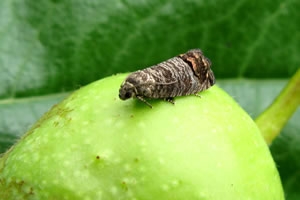While mating disruption (MD) for codling moth and oriental fruit moth is declining in Australian, in the US and Europe it is increasing each year.
Suggestions for the decline in Australia are that in MD orchards, secondary pests also need controlling and that this adds to the overall cost; that packing specifications are so high that the smallest blemish results in rejected fruit; the cost of MD itself; or perhaps it’s because new sprays are so effective and generally not disruptive to beneficial insects that we don’t need MD anymore.
In the USA the development of new techniques to improve and/or reduce the cost of using sex pheromones for mating disruption to manage codling moth remains an important objective in their tree fruit pest management research.
MD is the basis of their pest management programs, and multimillion dollar research projects are providing information on the efficacy of different kairomone and blends for codling moth control.
The latest development by researchers at the USDA, ARS, Yakima Agricultural Research Laboratory, Wapato, WA in collaboration with researchers at Oregon State University, are testing the effectiveness of MD ties loaded with either sex pheromone alone, or in combination with pear ester for mating disruption of codling moth.
Pheromone trials
Sex pheromone
The sex pheromone (E,E)-8,10-dodecadien-1-ol (codlemone) is the sex scent of the female codling moth. This is the standard pheromone in all MD dispensers in Australia.
This pheromone is released throughout the orchard so the orchard is flooded with the female sex scent—this confuses the male codling moth so he can’t perform, he is confused and is shut down.
Pear volatile
The pear volatile, (E,Z)-2,4-decadienoate (pear ester) or DA is a kairomone for female and male codling moths. It is a natural volatile produced from ripening pears.
Female moths use the pear ester to locate specific sites to lay eggs, and males use this kairomone to home in on the area where females are likely to be.
Combo dispenser trials
Studies were conducted with hand-applied combo dispensers loaded with codlemone (sex pheromone) together with pear ester for control of codling moth.
Two rates of combo dispensers were tested and compared with dispensers loaded only with codlemone. The CM Combo dispensers were applied at 800 per hectare.
CM Meso Combo dispensers were applied at 80 per hectare, and were loaded with 10 times the rates of each component in the same ratio.
Findings
Continued next issue
See this article and images in Tree Fruit August 2013




















